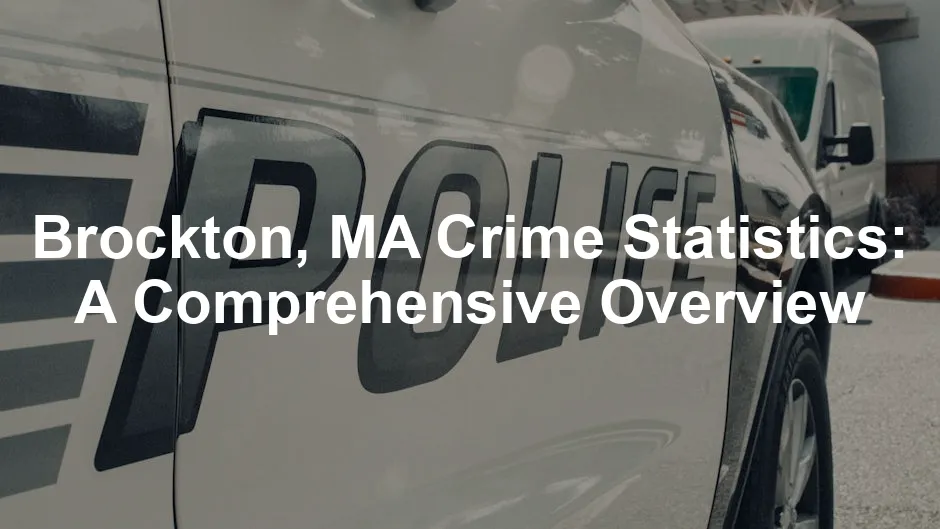Introduction
Brockton, Massachusetts, fondly known as the “City of Champions,” is a vibrant city located approximately 25 miles south of Boston. Nestled in Plymouth County, Brockton boasts a rich history and diverse population. With its proximity to Boston, many residents are drawn to the city’s blend of urban and suburban living. However, understanding crime statistics in Brockton is crucial for current residents, potential movers, and policymakers.
Crime statistics provide insights into the safety of a community. For residents, they help gauge safety levels and identify potential risks. For those considering relocation, these statistics play a pivotal role in their decision-making process. Policymakers utilize crime data to allocate resources effectively and implement safety measures.
In this article, we will explore detailed crime statistics in Brockton, examining trends, safety perceptions, and comparisons with neighboring areas. By understanding these statistics, readers can better assess the safety landscape of Brockton and make informed decisions regarding living, commuting, and engaging with the community.

Crime Overview
General Crime Information
Brockton faces significant challenges regarding crime. The overall crime rate in Brockton is 25 crimes per 1,000 residents, which far exceeds national averages. In fact, Brockton ranks higher than 97% of cities and towns in Massachusetts, making it a notable concern for residents and local authorities alike.
The likelihood of becoming a victim of crime in Brockton is, unfortunately, quite high. Statistically, residents face a 1 in 40 chance of being victimized. This alarming statistic highlights the need for increased awareness and safety measures in the area.
When examining the crime index values, Brockton’s index stands at 2,605.49, significantly above the Massachusetts average of 1,368.47 and the national average of 1,669.05. This stark contrast indicates that Brockton experiences crime rates well above what many other communities face, emphasizing the importance of addressing these issues head-on.

Understanding these statistics is vital for fostering a safer community. By recognizing the challenges and trends, residents can engage with local initiatives aimed at improving safety and reducing crime rates. Additionally, if you’re looking to dive deeper into crime and its societal impacts, consider reading Crime and Punishment by Fyodor Dostoevsky. It’s a classic that explores the psychology behind crime and morality.
Crime Rate Trends
Brockton, MA, has seen notable shifts in crime rates over recent years. While the overall crime landscape remains concerning, some trends show fluctuations. The total crime rate currently stands at 25 crimes per 1,000 residents, significantly higher than both state and national averages.
Violent crime rates have experienced a slight increase, with a reported total of 712 violent crimes in the latest statistics. This translates to a violent crime rate of 6.79 per 1,000 residents. Historical data reveals that there was a 5.5% increase in violent crimes from the previous year. Notably, assaults constitute the majority of these incidents, with 561 reported cases, showcasing the urgent need for community safety measures.
On the property crime side, Brockton reported 1,907 incidents, leading to a property crime rate of 18.19 per 1,000 residents. This represents a 14.3% rise compared to the previous year. Such increases in property crimes, particularly burglaries and thefts, raise eyebrows and highlight the necessity for local law enforcement strategies to tackle these challenges.
Interestingly, when we glance back over a few years, there’s a silver lining: Brockton has seen a decline in violent crime rates from 2018 to 2022. However, the recent upticks suggest that the city’s safety is still a pressing concern. If you’re curious about the societal implications of crime and mass incarceration, check out The New Jim Crow by Michelle Alexander.
In summary, while Brockton has made strides in reducing certain violent crimes over time, the recent increases in both violent and property crimes call for continued vigilance and effective crime prevention initiatives. The community must stay engaged and proactive in addressing these challenges to ensure a safer environment for all.

Violent Crime Statistics
Overview of Violent Crimes
Brockton’s violent crime statistics paint a vivid picture of the challenges the community faces. In total, 712 violent crimes were reported, resulting in a violent crime rate of 6.79 per 1,000 residents. This statistic places Brockton among the higher echelons of violent crime rates in the nation.
Breaking it down further, the violent crimes include:
- Murder: 8 incidents, giving Brockton a murder rate of 0.08 per 1,000 residents.
- Rape: 78 incidents, which equates to a rate of 0.74 per 1,000 residents.
- Robbery: 65 incidents, translating to a robbery rate of 0.62 per 1,000 residents.
- Assault: A staggering 561 incidents, leading to an assault rate of 5.35 per 1,000 residents.
These figures reveal the pressing nature of violent crime in Brockton. For context, the national median for violent crime is significantly lower, indicating the urgency for effective local interventions. Understanding campus sexual assault statistics can also provide insights into broader trends in violence. If you’re intrigued by crime stories, consider reading The Stranger Beside Me by Ann Rule. It’s a gripping true crime narrative that explores the mind of a killer.
Understanding crime statistics, including campus sexual assault statistics, is crucial for fostering community awareness and safety measures.
The chances of becoming a victim of violent crime in Brockton stand at 1 in 147. This statistic highlights the need for community awareness and safety measures. As the city grapples with these challenges, residents are encouraged to engage with local law enforcement and community programs aimed at reducing crime.
In conclusion, while Brockton faces a significant hurdle with its violent crime rates, understanding these statistics is the first step toward fostering a safer community. By staying informed and involved, residents can work together to mitigate these issues and improve public safety.

Specific Violent Crime Breakdown
Murder: Brockton reported 8 murders last year. This number gives the city a murder rate of 0.08 per 1,000 residents. Nationally, the murder rate hovers around 6.3 per 100,000 people, making Brockton’s figure appear relatively low. Still, any loss of life is tragic, and residents are understandably concerned.
Rape: The statistics for rape in Brockton stand at 78 incidents. This translates to a rate of 0.74 per 1,000 residents. Comparatively, the national average is approximately 40.0 per 100,000 residents, indicating that Brockton’s rate is noticeably higher. This statistic highlights an urgent need for community awareness and support for survivors.
Robbery and Assault: In terms of robbery, Brockton witnessed 65 incidents, resulting in a robbery rate of 0.62 per 1,000 residents. Assault statistics reveal a staggering 561 incidents, leading to an assault rate of 5.35 per 1,000 residents. These figures underscore the pressing nature of violent crime in the city, emphasizing the importance of local initiatives aimed at reducing crime and improving safety. For those interested in the psychological aspects of crime, consider Mindhunter by John E. Douglas. It delves into the minds of serial killers and the FBI’s efforts to understand them.

Comparison with National Averages
When we take a step back and look at Brockton’s violent crime statistics in comparison with national averages, the disparities become clear. Brockton’s overall violent crime rate sits at 6.79 per 1,000 residents, which is significantly higher than the national median of 2.68 per 1,000. The implications of these numbers are critical for understanding the safety landscape in Brockton.
For instance, while Brockton’s murder rate at 0.08 per 1,000 residents may seem low, it still raises alarms when placed alongside the national average of 6.3 per 100,000. The statistics for rape reveal a similar story—Brockton’s 0.74 per 1,000 residents is markedly higher than the national figure.
Robbery rates in Brockton, at 0.62, are lower than the national average of 66.1 per 100,000, while the assault rate is troublingly higher, with Brockton showing 5.35 per 1,000 compared to the national average of 268.2 per 100,000. This juxtaposition paints a complex picture of crime in Brockton, indicating both progress in certain areas and significant challenges in others, particularly regarding violent crimes. If you’re interested in understanding the roots of violence, The Anatomy of Violence by Adrian Raine is a must-read.
Understanding these statistics within a national context is crucial for residents, potential movers, and local policymakers. It lays the groundwork for conversations about safety, community resources, and the importance of local law enforcement and outreach programs. In essence, these statistics are more than just numbers—they represent the lived experiences of Brockton’s residents and highlight the need for continued efforts toward community safety and well-being.

Specific Property Crime Breakdown
Burglary: In Brockton, there were 289 reported burglaries. This rate translates to about 2.76 incidents per 1,000 residents. When we compare this with state averages, Brockton’s burglary rate is slightly lower than the Massachusetts average of 262.5 per 100,000 residents. Nationally, the average stands at 269.8 per 100,000, indicating that while Brockton faces challenges, it’s not the worst in the nation. Nevertheless, a burglary is still a violation of personal space, and residents are understandably concerned.
Theft: Theft is a significant issue in Brockton, with a staggering 1,124 incidents reported. This figure equates to a theft rate of 10.72 per 1,000 residents. Types of thefts reported include shoplifting, pickpocketing, and residential thefts. Interestingly, Brockton’s theft figures are lower than the national average of 1,401.9 per 100,000 residents, suggesting that local law enforcement may be making strides in addressing this problem. However, with over a thousand thefts, there’s still ample room for improvement. To enhance home security, consider investing in a Home Security Camera System. It can provide peace of mind and help deter potential thieves!
Motor Vehicle Theft: The motor vehicle theft rate in Brockton is particularly alarming, with 494 reported incidents. This results in a rate of 4.71 per 1,000 residents. Statistically, residents face a 1 in 212 chance of having their vehicle stolen. When compared to the national average of 282.7 per 100,000, Brockton’s figures are indeed concerning and highlight the city’s ongoing struggle with vehicle-related crimes.

Comparison with National Averages
When we stack Brockton’s property crime statistics against national averages, several insights emerge. The city’s overall property crime rate sits at 18.19 per 1,000 residents, which is slightly below the national average of approximately 20 per 1,000 residents. This indicates that while property crimes are prevalent, Brockton isn’t far off from the national norm. However, the high rates of motor vehicle theft and theft incidents suggest the city must continue addressing these issues to ensure residents feel more secure in their homes and communities. For additional safety, consider having a Personal Safety Alarm Keychain handy!
By understanding these statistics, residents can engage more effectively with community safety initiatives and advocate for necessary changes. Knowledge is power, after all!

Community Initiatives and Safety Programs
Brockton’s approach to safety is more than just numbers. It involves actively engaging the community. Local law enforcement has embraced community policing initiatives. This strategy fosters trust, communication, and collaboration between residents and officers. With police presence at community events, residents feel more connected. It’s like a neighborhood watch, but with more donuts and less spying!
Programs like “Brockton’s Neighborhood Crime Watch” empower citizens. They encourage residents to report suspicious activities. This proactive stance has proven effective in reducing crime. It’s all hands on deck—literally! If you want to stay informed about crime prevention strategies, The Crime Book: Big Ideas Simply Explained is a fantastic resource!
Moreover, Brockton has launched various safety programs targeting youth. The “Youth Police Academy” provides young people insights into law enforcement. Kids learn about crime prevention, conflict resolution, and teamwork. This initiative helps cultivate positive relationships with police. It’s like building a bridge, but with badges and better snacks!
Local law enforcement also prioritizes transparency. Regular community meetings allow officers to share updates. Residents can voice concerns, ask questions, and engage in constructive discussions. This open dialogue is crucial for creating a safe environment. After all, who doesn’t want to chat about safety over a good cup of coffee?
The collaboration doesn’t end there. Nonprofits and local organizations work hand-in-hand with police. They address underlying issues like poverty and education. Programs offering job training and mentorship play a vital role. These initiatives help steer individuals away from crime. It’s community resilience at its finest! And for those who want to relax a bit, an Essential Oil Diffuser can create a calming atmosphere at home.
In summary, Brockton’s community initiatives and safety programs reflect a commitment to collaboration. By fostering relationships between residents and law enforcement, the city takes a proactive stance on crime prevention. The blend of engagement, education, and empowerment cultivates a safer Brockton for everyone. Keep an eye out for those neighborhood meetings. Who knows? You might just make a new friend!
Please let us know what you think about our content by leaving a comment down below!
Thank you for reading till here 🙂
All images from Pexels




